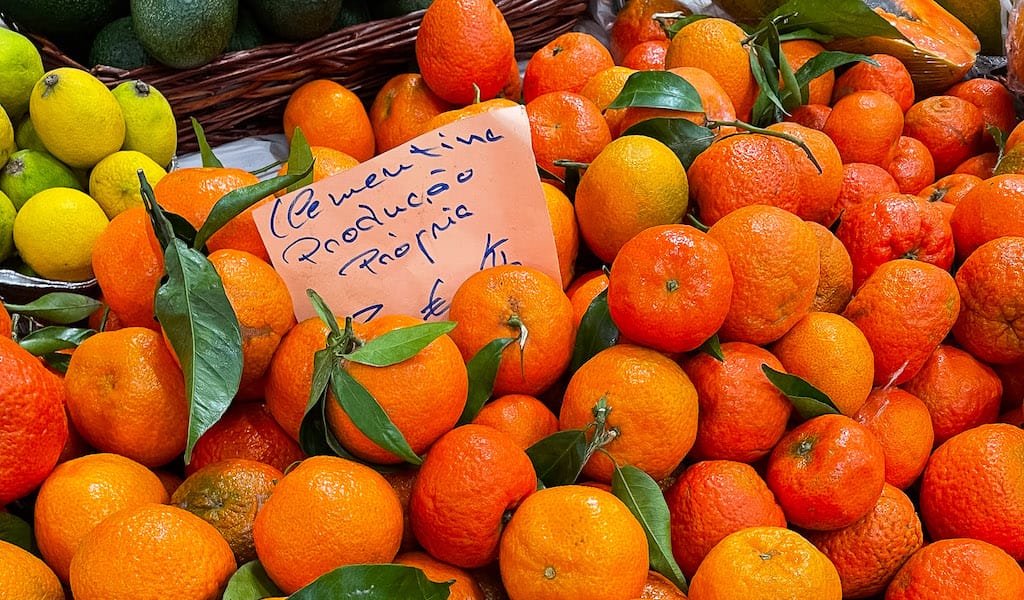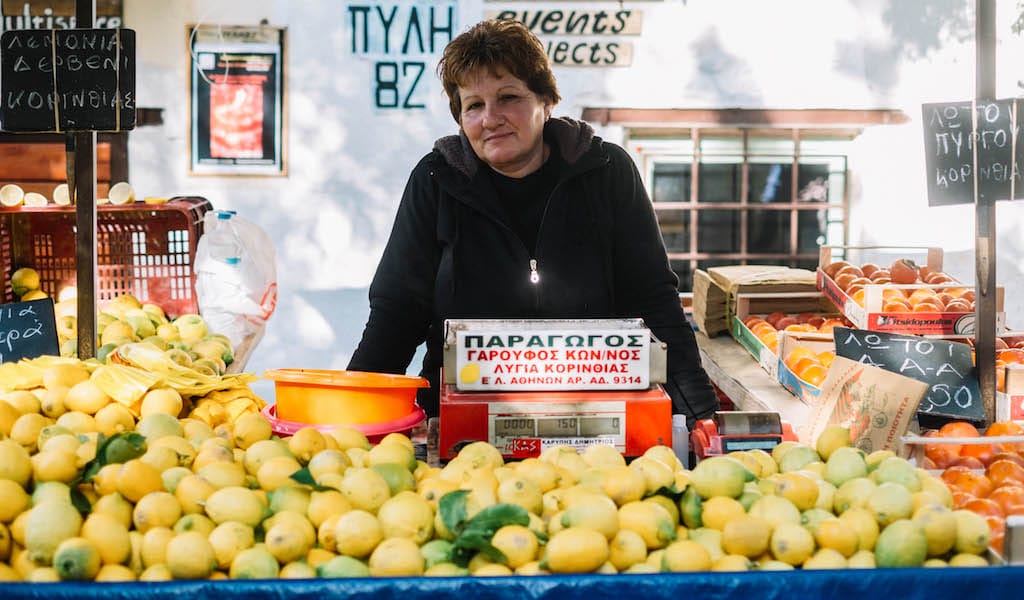What a year this was. The breath of fresh air that returned to Lisbon after the lifting of pandemic regulations was tempered by the tragic return of war to Europe. Rising inflation and the difficulty local restauranteurs faced to find staff created further challenges for Lisbon’s food industry, which was only starting to emerge out of its Covid-induced slumber. Still, the summer of 2022 was quite busy for restaurants with crowds returning to gather around a table, celebrating food and wine without masks and without groups restrictions. We were happy to return to some of the places we love the most, and discover new restaurants, bars and bites that the past year has brought to Lisbon.
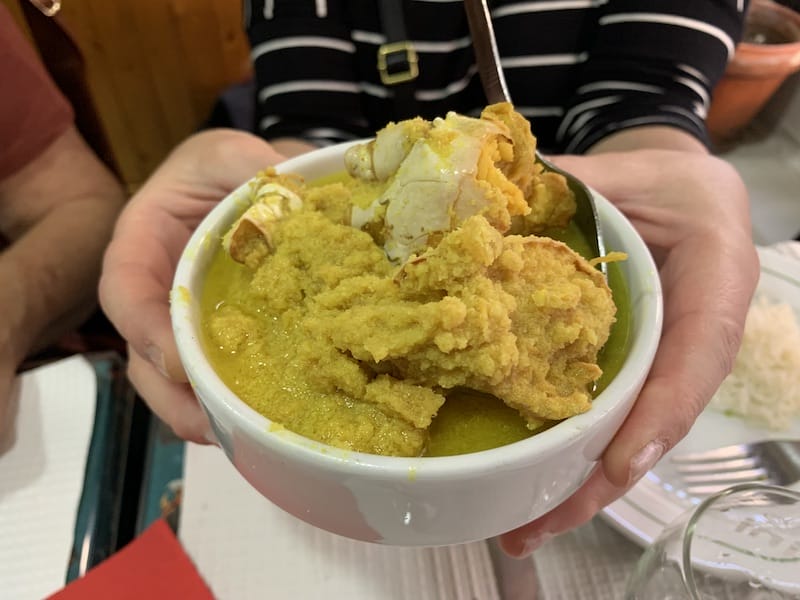
Goan Crab Xec Xec
Saved in my camera roll is the xec xec de caranguejo (crab xec xec) at Sabores de Goa. It’s a light and aromatic curry made with crab, turmeric and freshly grated coconut, the ingredient that makes all the difference. It’s still on my mind since I tasted it for the first time several months ago. “If it’s coconut from a package, it’s not the same,” the owners of this small family-run restaurant in Arroios (Bairro das Novas Nações) say. Spicy and fresh, the dish is as wonderful as it sounds, getting spicier as you reach the end of the bowl. Xec xec is a traditional dish in Goa – the name probably related to “crab,” as we’re told by a university professor originally from Goa, a regular at this temple of traditional Goan food. The turmeric and coriander seeds complete the punch of this fragrant dish, best eaten with your hands (ask for a bib, don’t be shy). With brothers Manuel and Sérgio hosting, Sabores de Goa is a joy to visit, and one of the stops in our new Lisbon Post-Colonial Feast walk.
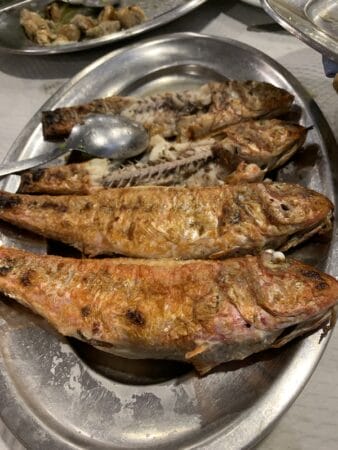
Grilled Red Mullet
Another favorite meal was during a group lunch on one of our multi-day culinary trips in October: the red mullet (salmonete in Portuguese) grilled to perfection at Batareo, a celebrated fish restaurant in Setúbal, around one hour south of Lisbon. The larger fish are cut in half and then the liver is mashed and spread on the inside of the fish to prevent it from drying out. The mullet is recommended by owner João Valente, the fish whisperer of Setúbal restaurants. It is perfection on a plate and a tribute to the best way to cook the honorable red mullet: over charcoal, seasoned only with sea salt.
Beachside Razor Clam Rice
A good razor clam rice these days is hard to find in Lisbon. However, this year, in an unsuspecting beach bar in Fonte da Telha called Aroeira Beach Bar, I tasted an incredibly rich and flavorful rice stew filled with razor clams. Spicy with a lovely seasoning, it’s as good as the best rice dishes found along the pristine Ria Formosa shores down south in the Algarve. With this dish and the views of the wild Atlantic in front of me, I almost forgot about the illegal construction turning Fonte da Telha into an urban nightmare at the end of beautiful Costa da Caparica coast line, south of Lisbon. One portion of rice in a bubbling pot costs 38 euros but is more than enough for two or three people.
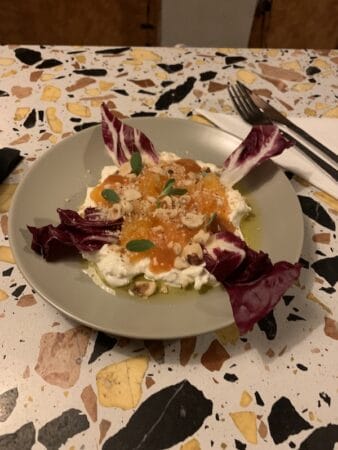
Liquid Love
The wonderful Liquid Love, a new bar in the city, served me a complex dish of pickled persimmons with stracciatella, hazelnuts and persimmon jam. It’s neither a dessert nor a savory dish, but it’s so delicious I’m still thinking about it. Cheila and Semi are the brains behind this project in Lisbon, located near Ramiro restaurant, which started out of their love for cocktails and delicious Italian-inspired food. Their heritage (Lisbon and Cabo Verde for Cheila and Italy and Tunisia for Semi) is reflected in the dishes here. Go for the cocktails and natural wines, stay for the stuzzicheria (snacks) and a chat with the lovely couple (preferably while sitting at the colorful counter where all the magic happens).

Pastries Worth Lining Up For
Pastelaria Bah, on the ground floor of Bairro Alto Hotel, had been on my radar since they re-opened, and this year I finally got to taste most of their delicious pastries, all baked with quality ingredients. Now I’m doomed and whenever I’m in the area of Chiado or Bairro Alto I never skip the jesuíta de amêndoa, a delicate and crispy pastry filled with a light, fresh custard and covered in toasted almonds, much different from any other jesuítas in the city. It’s truly amazing. The pastel de nata, with a soft and runny custard, is also quite good, similar to the ones chef Nuno Mendes used to bake in Taberna do Mercado. This pastelaria only has a few seats, but if it’s busy, I’ll go upstairs and escape from the crowded and noisy Camões Square in the comfortable lounge of the mezzanine with a book in one hand and an ephemeral pastry in the other. Both Bruno Rocha, the executive chef, alongside pastry chef Maria Abelho, deserve to have more people tasting these delightful pastries. They bake each to perfection and perfectly execute the concept that Nuno Mendes – in charge of all the menus of the restaurant – dreamed of. If there are lines for pastries elsewhere in the square, why not here?
– Célia Pedroso

Awa’s Baobab-sicles
Lisbon is blessed with an abundance of fruit trees. Poke your head over a garden wall and you’ll probably see fat lemons dangling there, possibly tangerines and bunches of loquat too. I’ve seen bananas growing in Mouraria and in October, a stiff breeze, like an air raid siren, warns me to take cover as avocados bomb my backyard. With all of Lisbon’s biodiversity, however, you will not encounter the baobab tree, that hulking species native to Africa and Australia.
That made it all the more exciting to find myself leaning against a railing overlooking São Domingos square sucking down a calabaceira popsicle made from the fruit of the baobab tree. This treat did not fall from the sky nor did I pluck it from the freezer at the corner minimercado. I made my way through a small flea market where merchandise such as old VHS tapes, tattered clothing and knick knacks crowd the ground. There I located a cohort of impeccably dressed Guinean women seated beside sacks of okra, kola nuts, cashews, peppers, and other foodstuffs from West Africa. And among them was Senhora Awa, sitting under a tree beside her cooler filled with homemade popsicles tied off in baggies. She had two kinds, one a deep ruby colored hibiscus and the prized cream-colored calabaceira. Upon further investigation, I learned that dehydrated fruit of the baobab tree is sold in shops all around here. Lisboetas with African roots are no stranger to the charms of calabaceira and may serve it as a drink at a dinner party. The taste reminded me of a Mexican horchata – creamy, sweet, sour and nutty. But the experience itself reminds me that surprising, delicious things I never even knew existed may be waiting around the next corner. That, to me, is the best kind of bite there is.
– Ansel Mullins
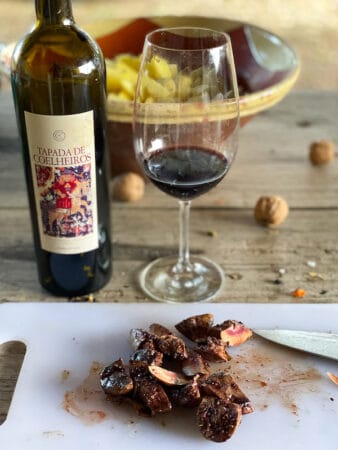
Deer kidneys and some extraordinary wine
After more than 20 years in Thailand, in February of 2022 I moved to Lisbon. As such, this has been a year of change for me, but also one of exploration. Every meal, every shopping trip, every pastry shop breakfast has been an opportunity to learn about the food of my new home. The lessons have been many and overwhelmingly delicious, but here are a few that stand out in my mind.
In September, I helped André Magalhães, chef-owner of Lisbon’s Taberna da Rua das Flores, at a cooking event at Tapada dos Coelheiros, a respected winery in Portugal’s Alentejo region. The groundskeeper had shot a deer on the property, and André was doing all kinds of amazing things with it, including roasting the haunches over a spit, stewing the offal in wine and making an amazingly rich and intense rice dish. But for me, the most delicious part was when we took the kidneys, sprinkled them with salt, grilled them over coals until just barely done, and ate them with the winery’s 2011 vintage.
As someone who lived for so long in Thailand, a place where dishes are often combinations of as many as tens of ingredients, the simplicity of things here in Portugal is novel and intriguing to me, and this utterly simple dish – if you could even call it that – was the epitome of this style of eating, and almost certainly the most delicious thing I ate in 2022.
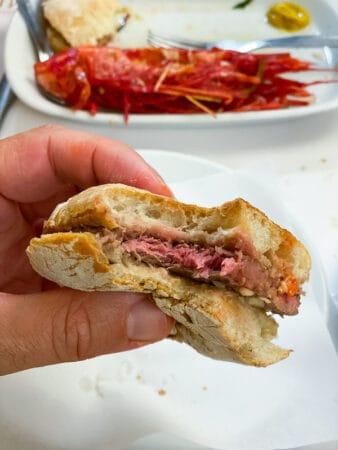
Steak dipped in scarlet prawn head
Everyone knows Ramiro, the palace of seafood that is probably the most famous restaurant in Portugal. But I’m not sure if everyone knows that dessert at Ramiro means a prego, a garlicky steak sandwich, typically slathered with sweet mustard. It’s utterly delicious, but at dinner at Ramiro in June, my friend, the former Pok Pok chef and owner Andy Ricker, upped this already over-the-top concept by dipping his prego in the fatty, rich head juices of a carabineiro, the deep sea cardinal shrimp or scarlet prawn. Is there a more decadent, delicious way to end a meal? I haven’t found one.
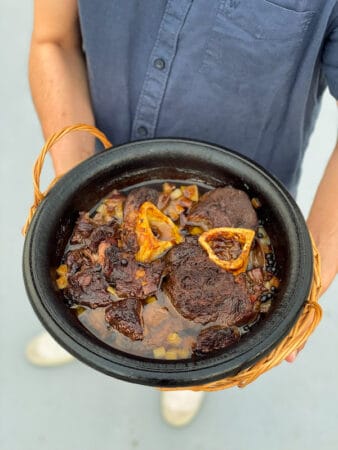
Alcatra on Terceira
In June, I made my first visit to the Azores. I accompanied my friend José, a native of Ilha Terceira, one of the nine islands of the archipelago, on a visit home. The signature dish of his home island is something called alcatra, beef braised with local white wine and spices in a special clay pot. I’d read about the dish before and asked José if we could make it. He was kind enough to oblige, and we spent an entire day shopping in Angra do Heroísmo – buying cuts of beef and cured pork fat from his favorite butcher, vegetables from the market, sweet bread and verdelho wine from the supermarket – and prepping, in the afternoon stopping into his grandparents’ house to borrow the requisite clay pot. After several hours of oven braising the acatra was done, and José, an aspiring chef and the youngest member of his family, was faced with serving the most traditional of dishes to the two older generations of his family. It was a success, and sharing this amazing spread with José and his family in their cozy home, contributing to the conversation in my broken Portuguese, was one of those meals that connected food, place, people and culture in a way that simply can’t be recreated at any restaurant.
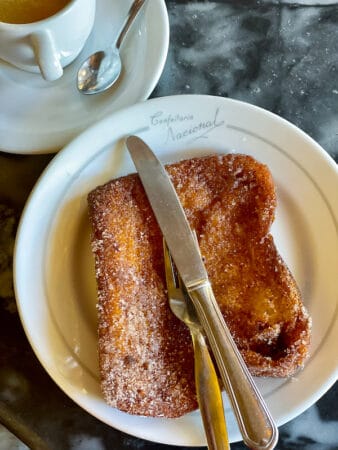
Rabanadas
I’m pretty sure that the majority of my breakfasts in 2022 have been consumed standing up at a pastelaria, or pastry shop. But just when I thought I’d tried just everything, the cold weather arrives and there’s an entire repertoire of items that are only served during the holiday season. Of these, my favorite is rabanadas, essentially a Portuguese twist on French toast. Taking the form of slices of bread soaked in milk, fried in oil and dusted with cinnamon sugar, they’re yet another genius way the Portuguese have found to utilize leftover bread. Given the increasingly cold weather and my running around town to shop for the Thai dinners I’ve been hosting, rabanadas, in particular those served at Confeitaria Nacional, have been a hearty, fragrant, delicious way to fuel up in the morning.
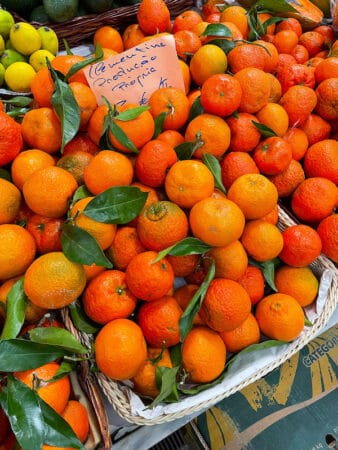
Lisbon’s Fresh Fruit
Almost certainly my most controversial opinion is this: I don’t really care for tropical fruit. After 20 years in Thailand, I got tired of the labor, time and mess involved in peeling and prepping much of the fruit in that part of the world, not to mention the expense and effort involved in sourcing the stuff that actually tastes good. Here in Portugal, I find that the fruit means much, much (much) less work while generally packing more flavor, and as a result I’m eating more fruit than I ever have before. My fruit obsession at the moment? Easy to peel, virtually seed-free, tart, fragrant clementines.
– Austin Bush
 December 18, 2014 Best Bites of 2014
December 18, 2014 Best Bites of 2014
Editor’s note: The year is coming to an end, which means it’s time for us to look back […] Posted in Rio January 20, 2019 Sunny Citrus in Keramikos
January 20, 2019 Sunny Citrus in Keramikos
On the day of the weekly street market, Keramikos comes alive in a riot of sights, […] Posted in Athens November 17, 2016 Baijiu in Beijing
November 17, 2016 Baijiu in Beijing
Baijiu, which translates literally as “white alcohol,” is a clear spirit made […] Posted in Beijing
Published on December 28, 2022
Related stories
December 18, 2014
Rio | By Taylor Barnes and Juarez Becoza
RioEditor’s note: The year is coming to an end, which means it’s time for us to look back on all the great eating and drinking experiences we had in 2014 and name our favorites among them. Ferro e Farinha We have the Fulbright Program to thank for this newcomer – a one-of-a-kind Rio dining destination.…
January 20, 2019
AthensOn the day of the weekly street market, Keramikos comes alive in a riot of sights, smells and flavors. We stroll through the open-air market on our Keramikos Calling walk, tasting what’s on offer from the vendors and getting a sense of the seasonality of Greek produce. Recently we spied these fragrant lemons, which provide…
November 17, 2016
BeijingBaijiu, which translates literally as “white alcohol,” is a clear spirit made predominately from sorghum, although glutinous rice, maize or other grains can also be utilized in various proportions. It is ubiquitous in China at official events, like weddings, business deals, and boozy government lunches, but under President’s Xi Jinping’s ongoing crackdown on government largesse,…







































